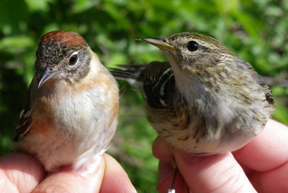A busy time in the marsh region both at the research banding station and around NW Ohio. The Biggest Week in American Birding is over but there are still birds to come. Flycatchers and vireos have not made their debut yet.
For the past four weeks the research team has had 181 banded birds returning from previous years. This is quite a significant group of birds and supports how birds home to the same area to breed each year. Something to remember when we see development in and near green spaces. There is an irreversible loss whenever habitat is taken and wildlife displaced.
A surprise this spring was this American Tree Sparrow (ATSP) which had an extended visited into early May. This is a good bird to add to any Ohio May list.
Some other sparrows for comparison:
Take a look at these pink beaked sparrows.
 |
| White-crowned Sparrow and Field Sparrow |
The weather patterns this spring have not been conducive for major pushes of birds. High pressure systems have dominated the region for most days the past couple of weeks. Diversity is here but not the volume of birds we saw last year.
We have had male Scarlet Tanagers (SCTA) singing at the research station but none have visited the banding table. However, one female came by for a quick visit. For those unfamiliar with Scarlet and Summer Tanager females, this wing flap of this Scarlet shows white axillaries while the Summer Tanager (SUTA) female shows yellow axillaries.
It is always a pleasure to have a Connecticut Warbler (CONW) visit our nets. This day we had two male CONWs and two male Mourning Warblers (MOWA).
On 13 May we were graced with many Chestnut-sided Warblers (CSWA). Twenty were banded that day and seven were caught in one net check.
Spring is the time to enjoy the colors of birds. We catch considerably more Blackpoll Warblers (BLPW) in the fall with their differential migration path. They fly from NW Canada southeast to the mid-Atlantic coast. In the spring they fly a more northerly direction from Venezuela resulting in fewer in the region.
Take a look at this handsome male BLPW. Despite his vivid coloration, he is still a second year bird (SY). Note its primary coverts are dull brown and worn.
Another good look at both male and female BLPW.
Highlights for this time were Cape May Warbler (CMWA).
Note the back coloration.
Orange-crowned Warbler (OCWA)
Bay-breasted Warbler male (BBWA)
And to top it off a couple females in blue:
Cerulean Warbler (CERW)
Black-throated Blue Warbler (BTBW)
Keep looking for southerly winds to create the opportunity for birds to ride north to Ohio on their way to their breeding grounds.
Enjoy the season!

































